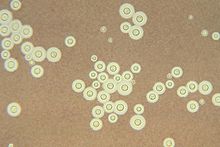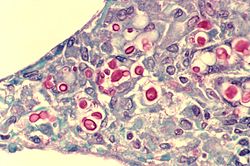- Cryptococcus neoformans
-
Cryptococcus neoformans 
Cryptococcus neoformans Scientific classification Kingdom: Fungi Phylum: Basidiomycota Class: Tremellomycetes Order: Tremellales Family: Tremellaceae Genus: Cryptococcus Species: Cryptococcus neoformans Binomial name Cryptococcus neoformans
(San Felice) Vuill.Cryptococcus neoformans is an encapsulated yeast that can live in both plants and animals. Its teleomorph is Filobasidiella neoformans, a filamentous fungus belonging to the class Tremellomycetes. It is often found in pigeon excrement.
Contents
Classification
Cryptococcus neoformans is composed of two varieties (v.): C. neoformans v. neoformans and v. grubii. A third variety, C. neoformans v. gattii, is now considered a distinct species, Cryptococcus gattii. C. neoformans v. grubii and v. neoformans have a worldwide distribution and are often found in soil which has been contaminated by bird excrement. The genome sequence of C. neoformans v. neoformans was published in 2005.[1] Recent studies suggest that colonies of Cryptococcus neoformans and related fungi growing on the ruins of the melted down reactor of the Chernobyl Nuclear Power Plant may be able to use the energy of radiation (primary beta radiation) for "radiotrophic" growth.[2]
Characteristics
Cryptococcus neoformans grows as a yeast (unicellular) and replicates by budding. C. neoformans makes hyphae during mating, and eventually creates basidiospores at the end of the hyphae before producing spores. Under host-relevant conditions, including low glucose, serum, 5% carbon dioxide, and low iron, among others, the cells produce a characteristic polysaccharide capsule. [3] When grown as a yeast, C. neoformans has a prominent capsule composed mostly of polysaccharides. Microscopically, the India ink stain is used for easy visualization of the capsule. The particles of ink pigment do not enter the capsule that surrounds the spherical yeast cell, resulting in a zone of clearance or "halo" around the cells. This allows for quick and easy identification of C. neoformans.
C. neoformans grows rapidly on exposure to radiation such as gamma-radiation. Radiation seems to increase the electron-transfer capability of melanin in the fungus, increasing its total metabolic activity.[4]
Pathology
Infection with C. neoformans is termed cryptococcosis. Most infections with C. neoformans consist of a lung infection.[citation needed] However, fungal meningitis, especially as a secondary infection for AIDS patients, is often caused by C. neoformans making it a particularly dangerous fungus. Infections with this fungus are rare in those with fully functioning immune systems.[5] For this reason, C. neoformans is sometimes referred to as an opportunistic fungus.[5] It is a facultative intracellular pathogen.[6]
Treatment
Cryptococcosis that does not affect the central nervous system can be treated with fluconazole alone.
Cryptococcal meningitis should be treated for two weeks with intravenous Amphotericin B 0.7–1.0 (mg/kg)/day and oral flucytosine 100 (mg/kg)/day (or intravenous flucytosine 75 (mg/kg)/day if the patient is unable to swallow). This should then be followed by oral fluconazole 200 mg daily for ten weeks[7] and then 200 mg daily until the patient's CD4 count is above 100 for three months and, if infected, his HIV viral load is undetectable.[8][9]
Intravenous Ambisome 4 (mg/kg)/day may be used but is not superior: its main use is in patients who do not tolerate Amphotericin B. The 200 (mg/kg)/day dose for flucytosine is not more effective, is associated with more side-effects and should not be used.
In Africa, oral fluconazole at a rate of 200 mg daily is used. However, this does not result in cure because it merely suppresses the fungus and does not kill it; viable fungus can continue to be grown from CSF of patients who have taken fluconazole for many months. An increased dose of 400 mg daily does not improve outcomes,[10] but preliminary data from Uganda shows that very high doses of 1200 mg or more per day may be effective. The duration of this treatment and the post-treatment maintenance dose is not known.
References
- ^ Loftus BJ, et al. (2005). "The genome of the basidiomycetous yeast and human pathogen Cryptococcus neoformans". Science 307 (5713): 1321–24. doi:10.1126/science.1103773. PMID 15653466.
- ^ Dadachova E, et al. (2007). Rutherford, Julian. ed. "Ionizing Radiation Changes the Electronic Properties of Melanin and Enhances the Growth of Melanized Fungi". PLoS One 2 (5): e457. doi:10.1371/journal.pone.0000457. PMC 1866175. PMID 17520016. http://www.pubmedcentral.nih.gov/articlerender.fcgi?tool=pmcentrez&artid=1866175.
- ^ [1]
- ^ Ionizing radiation changes the electronic properties of melanin and enhances the growth of melanized fungi. PLoS ONE 2 (5): e457
- ^ a b What Makes Cryptococcus neoformans a Pathogen?, Kent L. Buchanan and Juneann W. Murphy University of Oklahoma Health Sciences Center, Oklahoma City, Oklahoma, USA
- ^ doi:10.1186/1471-2180-9-51
This citation will be automatically completed in the next few minutes. You can jump the queue or expand by hand - ^ Saag MS, Graybill RJ, Larsen RA, et al. (2000). "Practice guidelines for the management of cryptococcal disease. Infectious Diseases Society of America". Clin Infect Dis 30 (4): 710–8. doi:10.1086/313757. PMID 10770733.
- ^ Martínez E, García-Viejo MA, Marcos MA, et al. (2000). "Discontinuation of secondary prophylaxis for cryptococcal meningitis in HIV-infected patients responding to highly active antiretroviral therapy". AIDS 14 (16): 2615–26. doi:10.1097/00002030-200011100-00029. PMID 11101078.
- ^ Vibhagool A, Sungkanuparph S, Mootsikapun P, et al. (2003). "Discontinuation of secondary prophylaxis for Cryptococcal meningitis in Human Immunodeficiency Virus-infected patients treated with highly active antiretroviral therapy: a prospective, multicenter, randomized study". Clin Infect Dis 36 (10): 1329–31. doi:10.1086/374849. PMID 12746781.
- ^ CF Schaars, Meintjes GA, Morroni C, et al. (2006). "Outcome of AIDS-associated cryptococcal meningitis initially treated with 200 mg/day or 400 mg/day of fluconazole". BMC Infect Dis 6: 118. doi:10.1186/1471-2334-6-118. PMC 1540428. PMID 16846523. http://www.pubmedcentral.nih.gov/articlerender.fcgi?tool=pmcentrez&artid=1540428.
External links
- A good overview of Cryptococcus neoformans biology from the Science Creative Quarterly
- Cryptococcus neoformans biology, general information, life cycle image at MetaPathogen
- The outcome of Cryptococcus neoformans intracellular pathogenesis in human monocytes
Infectious diseases · Mycoses and Mesomycetozoea (B35–B49, 110–118) Superficial and
cutaneous
(dermatomycosis):
Tinea=skin;
Piedra (exothrix/
endothrix)=hairBy locationTinea barbae/Tinea capitis (Kerion) · Tinea corporis (Ringworm, Dermatophytid) · Tinea cruris · Tinea manuum · Tinea pedis (Athlete's foot) · Tinea unguium/Onychomycosis (White superficial onychomycosis · Distal subungual onychomycosis · Proximal subungual onychomycosis)
Tinea corporis gladiatorum · Tinea faciei · Tinea imbricata · Tinea incognito · FavusBy organismEpidermophyton floccosum · Microsporum canis · Microsporum audouinii · Trichophyton interdigitale/mentagrophytes · Trichophyton tonsurans · Trichophyton schoenleini · Trichophyton rubrumOtherSubcutaneous,
systemic,
and opportunisticCoccidioides immitis/Coccidioides posadasii (Coccidioidomycosis, Disseminated coccidioidomycosis, Primary cutaneous coccidioidomycosis. Primary pulmonary coccidioidomycosis) · Histoplasma capsulatum (Histoplasmosis, Primary cutaneous histoplasmosis, Primary pulmonary histoplasmosis, Progressive disseminated histoplasmosis) · Histoplasma duboisii (African histoplasmosis) · Lacazia loboi (Lobomycosis) · Paracoccidioides brasiliensis (Paracoccidioidomycosis)OtherBlastomyces dermatitidis (Blastomycosis, North American blastomycosis, South American blastomycosis) · Sporothrix schenckii (Sporotrichosis) · Penicillium marneffei (Penicilliosis)Yeast-likeCandida albicans (Candidiasis, Oral, Esophageal, Vulvovaginal, Chronic mucocutaneous, Antibiotic candidiasis, Candidal intertrigo, Candidal onychomycosis, Candidal paronychia, Candidid, Diaper candidiasis, Congenital cutaneous candidiasis, Perianal candidiasis, Systemic candidiasis, Erosio interdigitalis blastomycetica) · C. glabrata · C. tropicalis · C. lusitaniae · Pneumocystis jirovecii (Pneumocystosis, Pneumocystis pneumonia)Mold-likeAspergillus (Aspergillosis, Aspergilloma, Allergic bronchopulmonary aspergillosis, Primary cutaneous aspergillosis) · Exophiala jeanselmei (Eumycetoma) · Fonsecaea pedrosoi/Fonsecaea compacta/Phialophora verrucosa (Chromoblastomycosis) · Geotrichum candidum (Geotrichosis) · Pseudallescheria boydii (Allescheriasis)Basidiobolus ranarum (Basidiobolomycosis) · Conidiobolus coronatus/Conidiobolus incongruus (Conidiobolomycosis)Mesomycetozoea Ungrouped Alternariosis · Fungal folliculitis · Fusarium (Fusariosis) · Granuloma gluteale infantum · Hyalohyphomycosis · Otomycosis · PhaeohyphomycosisCategories:- Tremellomycetes
- Yeasts
- Sequenced genomes
Wikimedia Foundation. 2010.

